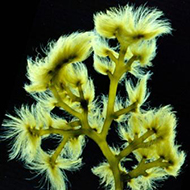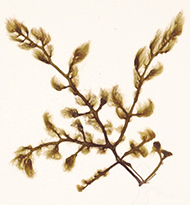Priorities Action Statement - Actions for Marine Brown Algae (Nereia lophocladia)
Recovery Actions

Advice to consent and determining authorities
- Ensure that all relevant stakeholders, including local councils and government agencies take Nereia lophocladia into consideration during development impact assessment procedures required by the Environmental Planning and Assessment Act 1979 and the Fisheries Management Act 1994 (High priority).
- Provide information on the distribution of the Nereia lophocladia to local councils and determining authorities to ensure appropriate consideration during development assessment processes (Medium priority).
Collate and review existing information

- Compile existing information on Nereia lophocladia and identify knowledge gaps for the purpose of targeting future research activities (High priority).
- Collate data on the historical distribution of Nereia lophocladia including anecdotal and indigenous knowledge (Low priority).
Community and stakeholder liaison, awareness and education
- Encourage community reporting of Nereia lophocladia via the department Threatened and Pest Species Sightings Program online form (High priority).
- Install signs and/or interpretive displays at appropriate locations to assist with identification and awareness of Nereia lophocladia (Medium priority).
- Implement education initiatives to improve awareness of the status of the Nereia lophocladia and ways to minimise impacts on the species by preparing and distributing appropriate advisory material (Low priority).
- Educate stakeholders on how to identify Nereia lophocladia from other marine algae (Low priority).
- Educate aquarium enthusiasts about the threatened status of Nereia lophocladia and the ban on collecting the species (Low priority).
Compliance / enforcement
- Maximise compliance activities at identified important sites (High priority).
Enhance, modify or implement NRM planning processes to minimize adverse impacts on threatened species
- Negotiate with relevant authorities to encourage the identification, assessment, and modification of natural resource management plans and policies to minimise impacts on Nereia lophocladia habitats and water quality (Medium priority).
- Consider existing knowledge of Nereia lophocladia in the development of marine parks and marine estate planning decisions (Medium priority).
Habitat protection
- Protect the few remaining sites that contain or with the potential to support the species (Medium priority).
Habitat rehabilitation
- Undertake work to identify, restore and protect known and potential Nereia lophocladia habitats and address key threats such as habitat degradation and water quality decline from expanding development (Medium priority).
Pest eradication and control
- Investigate and implement integrated management of introduced species in and adjacent to identified Nereia lophocladia habitats and take action to prevent the spread of introduced species into these habitats (High priority).
Research / monitoring
- Monitor Nereia lophocladia population over time to assess trends in abundance and distribution and to identify emerging threatening processes (High priority).
- Undertake research to identify, prioritise and improve understanding of the threatening processes and causes of decline of Nereia lophocladia (High priority).
- Actively seek grants or investor partnerships to fund research and monitoring programs for Nereia lophocladia (High priority).
- Obtain and analyse genetic material from remnant populations of Nereia lophocladia to identify genetic units to inform conservation breeding or translocation (High priority).
- Conduct research on the biology and ecology of Nereia lophocladia, particularly the species' ecological role, environmental tolerances, factors influencing population dynamics, age and growth, life cycle and diet (Medium priority).
- Actively encourage community involvement in aspects of Nereia lophocladia research and monitoring programs (Low priority).
Stocking / translocation
- Identify potential candidate sites for possible future translocation of Nereia lophocladia (High priority).
- Undertake emergency rescues of Nereia lophocladia in response to oil spills/ pollution, detection of biosecurity threats (e.g. disease or pests), or to avoid other detrimental impacts (High priority).
- Review and assess the potential of artificial refuge areas for the protection of Nereia lophocladia (Medium priority).
Survey / mapping
- Conduct targeted surveys to determine the current distribution and abundance of Nereia lophocladia (High priority).
- Collect data on the presence/absence of Nereia lophocladia during incidental surveys (Medium priority).
- Conduct seasonal dive surveys around Muttonbird Island to confirm the presence or absence of Nereia lophocladia and produce high resolution maps for use by relevant consent and determining authorities (Medium priority).




